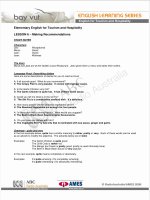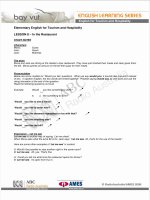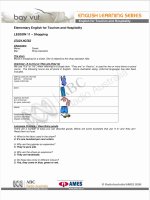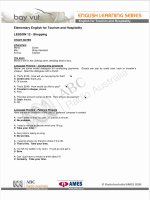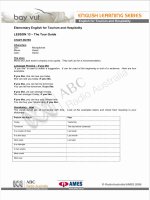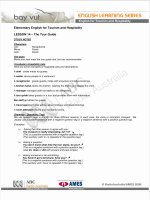Strategic Marketing for Tourism & Hospitality
Bạn đang xem bản rút gọn của tài liệu. Xem và tải ngay bản đầy đủ của tài liệu tại đây (636.67 KB, 128 trang )
Strategic Marketing
for Tourism & Hospitality
Hanoi Open University - Faculty of
Tourism
Lecturer: Tran Nu Ngoc Anh
Strategic Marketing for Tourism & Hospitality
Course Objectives
Understand strategic marketing concepts and strategic
marketing
tools in the tourism industry
Establish a strategic marketing plan for tourism organizations
Make a presentation and communicate the strategic
marketing terms in
English
Content
Chapter 1:
Marketing
Chapter 2:
Chapter 3:
Chapter 4:
Chapter 5:
Chapter 6:
Chapter 7:
Chapter 8:
Chapter 9:
Introduction to Marketing and Tourism
Introduction to Strategic Marketing
Macro Marketing Environment Analysis
Micro Marketing Environment Analysis
Market Analysis
Pricing
Positioning the Product
Advertising and Publicity
Effective Sales of Travel Products and Services
Strategic Marketing for Tourism & Hospitality
Duration of the Course
45 periods (03 credits)
9 lessons (indoor class)
Exams
Participation:
10% of the total mark
Course Project: 30% of the total mark
& condition to take the final exam
Final exam:
60% of the total mark (multi choice + open questions)
If students do not do the course project,
he/she will be not allowed to take the final
exam.
Strategic
Marketing for Tourism & Hospitality
Course
Project
Establish a strategic marketing plan for a tourism organization
that you
know well, including following compulsory requirements:
6.
Introduction to the organization & Macro environment
analysis for the selected organization
The organization analysis
The competitor analysis (Analyze with at least 2 main
competitors)
The market analysis and questionnaire designed
Mission statement, Goals and Objectives & Marketing
strategies (9Ps)
Marketing tactics
positioning statement
7.
Marketing tactics
8.
Implementing the marketing plan
Choose one marketing book/group to share with
1.
2.
3.
4.
5.
9.
the cover of print ad (A4 size)
letter persuading customers to buy
services, sales promotions …
Chapter 1
Introduction to Marketing & Tourism
Marketing
Learning Objectives
Be
aware of Marketing , Service
Marketing & Tourism Marketing concepts
Identify the similarity and the
differences between Service Marketing
& Tourism Marketing
List characteristics of Services and
Marketing - Mix Components
Classify the differences between
Chapter 1:
Introduction to Marketing and Tourism
Marketing
Marketing Research
Find wants and fill them (R ST PDB MM
I C)
Push - Pull Strategy
3R (Retain loyal customers, Retrieve lost
customers,
Recruit new customers)
Participants: All staff of an organization
Marketing Mix: 4P (Product, Place, Promotion,
Price)
Chapter 1:
Introduction to Marketing and Tourism
Marketing
Marketing mix - 4P
4P of Marketing
+
+
+
+
Product
Place
Promotion
Price
Chapter 1: Introduction to Marketing and Tourism Marketing
+ Product
Sản phẩm cốt lõi
(core product
components
Sản
phẩm hiện
Bảo hành
Bao bì
Hình
thức
tín
dụng
Hình
dáng
Những lợi
ích cơ
bản mang
lại
Đặc
tính
sản
phẩm
Tiêu chuẩn chất lợng
Lắp đặt
Phục
vụ
bán
thực
Sản phẩm bao
quanh
Real product
(appearance)
Sản phẩm bổ sung
(supplementary services)
Chapter 1: Introduction to Marketing and Tourism Marketing
Chu kú sèng cña s¶n phÈm (Product Life Cycle)
Doanh
sè
H×nh thµnh
T¨ng trëng (PT)
thµnh
Suy tho¸i
Establishment Development
Decline
Trëng
Mature
Thêi
gian
Chapter 1: Introduction to Marketing and Tourism Marketing
Chu kú sèng cña s¶n phÈm (Product Life Cycle)
Establishment Growth
Mature
Decline
Revenue
Low
Increase
fast
Max
Low
Cost
High
Average
Low
Low
Profit
Loss
Increase
High
Low
Customers
Pioneers
Increase
Big No
Late
Followers
Competitors
Few
Increase
Stable
Decrease
Chapter 1: Introduction to Marketing and Tourism Marketing
+ Place
Kho tµng
Ngêi s¶n xuÊt
Producer
Hµng hãa
(Chuçi
VËn )Trung
t¶i
gian
Th«ng tin
Kho tµng Hµng hãa
VËn
t¶i
Ngêi mua
Buyer
Chapter 1: Introduction to Marketing and Tourism Marketing
+ Place
Kênh trực tuyến (MC)
Kênh ngắn (MRC)
Nhà
sản
Kênh dài (MWRC)
xuất Ngời
ngời
Kênh dài
bán
làm
đầy đủ
buôn
marketi
(MJWRC)
Môi
ng
(W)
giới
(J)
(M)
Ngời
bán lẻ
(R)
Ngời
tiêu
dùng ngời
mua
(C)
Chapter 1:
Introduction to Marketing and Tourism
Marketing
Tourism Services Research
Intangibility
Inseparability
Variability
Perish
ability
No ownership
"4S" Model in USA (SEA, SUN, SHOP,
SEX or SAND)
3H
Model
in
USA
HOSPITALITY, HONESTY)
(HERITAGE,
Chapter 1: Introduction to Marketing & Tourism
Marketing
What is SERVICE ?
Smile for everyone
Excellence in everything we do
Reaching out to all guests with
hospitality
Viewing every guest as special
Inviting guests to return
Creating a warm atmosphere
Eye contact that shows we care
Chapter 1:
Introduction to Marketing and Tourism
Marketing
Product & service Marketing
Research
Product Marketing
=
Products - Consumers
Service Marketing
=
Products - Customers
Services
Staff is the bridge of
Products to
customers
Chapter 1:
Introduction to Marketing and Tourism
Marketing
Tourism Marketing Research
Tourism Marketing
=
Products - Tourists
Services
tourists’ expectations
business objectives
Chapter 1:
Introduction to Marketing and Tourism
Marketing
Marketing mix - (9P) In tourism
4P of Marketing 5P of Marketing
Tourism
+
+
+
+
Product
Place
Promotion
Price
+
+
+
+
+
People
Packaging
Positioning
Programming
Partnership
in
Chapter 2
Introduction to Strategic
Marketing
Learning Objectives
Be aware of Strategic Marketing Plan concept,
components of a strategic marketing Plan for
Tourism and Hospitality Organizations and the
importance of strategic marketing for Tourism
and Hospitality.
Practise to write Mission Statements for
Tourism Industry and Tourism Organizations.
Classify Objectives, Strategies and Tactics and
practise to formulate Objectives, Strategies
and Tactics for Tourism Organizations.
Be able to apply SWOT matrix to analyse the
tourism organizations’ business environment.
Chapter 2
Introduction to Strategic
Marketing
Main content
1.
2.
3.
4.
5.
Strategic Marketing Planning
The Mission Statement
Objectives, strategies, tactics
SWOT matrix in Tourism Industry
Discussions and Practices
Chapter 2:
Introduction to Strategic Marketing
Strategic Planning
Strategic planning
=
organization’s resources + opportunities
objectives, strategies & tactics
marketing efforts
Strategic planning is the managerial process of developing and keeping an
optimal fit between the deployment of an organization’s resources and the
opportunities in its changing environment in order to establish its
objectives, formulate its strategies and tactics (to guide its marketing
efforts).
Chapter 2:
Introduction to Strategic Marketing
Goals of Strategic marketing
Maintain the balance between:
Profits of Tourism Organizations
Satisfaction of Tourists
Strategic Marketing means to enforce
the relationship between :
Tourists & your organization
Chapter 2:
Introduction to Strategic Marketing
Goals of Strategic marketing
Recruit new customers
Good
company name
Sales
Retain loyal customers
Retrieve lost customers
Effective
products & services
Customers’
satisfaction
•Promotion
• Introduction
•High quality program
•Product design
to services
•Good relationship
•Pricing
& Sales
•Advertisement •Internal & external•Excellent amenities with customers
and facilities
Sales
•Publicity
•Training
Chapter 2:
Introduction to Strategic Marketing
Strategic Planning Steps
Step 1
Step 2
Situational Analysis
Target market
Step 6
Step 3
Product Positioning
Controlling &
Evaluating
Step 5
Step 4
Implementing
Objectives,
strategies &
Strategic Marketing for Tourism & Hospitality
Content of A marketing Plan
1. Introduction to the tourism organization
2.
Overview of the strategic marketing plan
3.
The organization’s marketing environment
analysis
4.
The market analysis
5.
Mission statement
6.
Objectives
Marketing strategies and tactics
7.
8.
Implementing the marketing plan
Một khách sạn không ngừng nâng cấp chất lợng dịch vụ và
đào tạo nhân viên.
Bằng cách đảm bảo hoạt động kinh doanh có hiệu quả và
uy tín trên thị trờng, khách sạn Sofitel Metropole cam kết
với:
Nhà đầu t: Tiền lời tối u trên vốn đầu t
- Không ngừng xây dựng những chiến lợc kinh
doanh mới.
- Thận trọng trong việc sử dụng ngân sách điều
hành.
Khách: Sự kết hợp của tính hiếu khách Việt Nam với phong
cách châu Âu.
- Tối đa sự thoải mái và phục vụ từng cá nhân
khách với một nụ cời.
- Tuyệt hảo về chất lợng và đáng giá với đồng tiền.
Nhân viên: Cơ hội để gia tăng kỹ năng và phát triển cá
nhân.
- Đào tạo theo tiêu chuẩn khách sạn quốc tế.
- Đợc tham gia vào các chơng trình phát triển nghề

